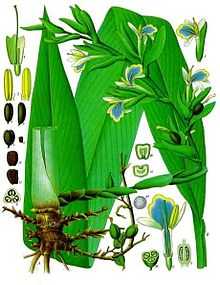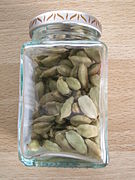Cardamom
| Cardamom | |
|---|---|
 | |
| True cardamom (E. cardamomum) | |
| Scientific classification | |
| Kingdom: | Plantae |
| (unranked): | Angiosperms |
| (unranked): | Monocots |
| (unranked): | Commelinids |
| Order: | Zingiberales |
| Family: | Zingiberaceae |
| Genera | |
Cardamom (/ˈkɑrdəməm/), sometimes called cardamon, is a spice made from the seeds of several plants in the genera Elettaria and Amomum in the family Zingiberaceae. Both genera are native to India, Pakistan, Nepal, and Bhutan; they are recognised by their small seed pods, triangular in cross-section and spindle-shaped, with a thin, papery outer shell and small black seeds. Guatemala, where the German coffee planter Oscar Majus Kloeffer introduced Indian cardamom before World War I,[1] has become the biggest producer and exporter of cardamom in the world, followed by India. Some other countries, such as Sri Lanka, have also begun to cultivate it. Elettaria pods are light green, while Amomum pods are larger and dark brown.
It is the world's third-most expensive spice, surpassed in price per weight only by saffron and vanilla.
Etymology
The word "cardamom" is derived from the Latin cardamomum,[2] itself the latinisation of the Greek καρδάμωμον (kardamomon),[3] a compound of κάρδαμον (kardamon), "cress"[4] + ἄμωμον (amomon), which was probably the name for a kind of Indian spice plant.[5] The earliest attested form of the word κάρδαμον signifying cress is the Mycenaean Greek ka-da-mi-ja, written in Linear B syllabic script,[6] in the list of flavourings on the "Spice" tablets found among palace archives in the House of the Sphinxes in Mycenae.[7]
In the New Testament (which was largely written in Greek), the word amomon [ἄμωμον] appears in reference to an aromatic plant product (Rev. 18:13), and is often translated as 'spice'. 'Aμωμον' could be derived—and some books state so—from the adjective amomos [ἄμωμος] "blameless, without reproach"; given, however, that amomos is a regional and poetic form, this may be less probable than (what other books state) the derivation from Aramaic hemama, which was not able to be verified.
The modern genus name Elettaria is derived from the local name. The root ēlam is attested in all Dravidian languages[8] viz. Kannada elakki [ಏಲಕ್ಕಿ], Telugu yelakulu [యేలకులు], Tamil elakkai [ஏலக்காய்] and Malayalam elakkay [ഏലക്കായ്]. The second element kai means "seed" or "fruit". The Malabar region had historical trade connections and was a prominent area of cardamom cultivation. A related root is also present in Hindi ilaychi [इलायची], Bengali elachi [এলাচি] and Punjabi ilaichi [ਇਲੈਚੀ] "green cardamom". The common source is Sanskrit, where cardamom is called ela [एला] or ellka [एल्ल्का]. In Marathi it is commonly known as Velchi [वेलची] or Veldoda [वेलदोडा][9]
Types and distribution

There are two main types of cardamom:
- True or green cardamom (or, when bleached, white cardamom[10]) comes from the species Elettaria cardamomum and is distributed from India to Malaysia.
- Black cardamom, also known as brown, greater, longer, or Nepal cardamom, comes from two species, Amomum costatum and Amomum subulatum, which are distributed mainly in Asia and Australia.
The two types of cardamom, κάρδαμομον and ἄμωμον, were distinguished in the fourth century BCE by the Greek father of botany, Theophrastus. Some of his unknown informants told him these varieties came to Greece from the land of the Medes in northern Persia, while others were aware it came originally from India.[11]
Uses
Both forms of cardamom are used as flavorings and cooking spices in both food and drink, and as a medicine. E. cardamomum (green cardamom) is used as a spice, a masticatory, and in medicine; it is also smoked, sometimes.
Food and drink


Cardamom has a strong, unique taste, with an intensely aromatic, resinous fragrance. Black cardamom has a distinctly more smokey, though not bitter, aroma, with a coolness some consider similar to mint.
Green cardamom is one of the most expensive spices by weight, but little is needed to impart flavor. It is best stored in pod form because once the seeds are exposed or ground, they quickly lose their flavor. Grinding the pods and seeds together lowers both the quality and the price. For recipes requiring whole cardamom pods, a generally accepted equivalent is 10 pods equals 1½ teaspoons of ground cardamom.
It is a common ingredient in Indian cooking and is often used in baking in the Nordic countries, in particular in Sweden and Finland, where it is used in traditional treats such as Finnish sweet bread pulla and in the Scandinavian Christmas bread Julekake. In the Middle East, green cardamom powder is used as a spice for sweet dishes, as well as traditional flavouring in coffee and tea. Cardamom is used to a wide extent in savoury dishes. In some Middle Eastern countries, coffee and cardamom are often ground in a wooden mortar, a mihbaj, and cooked together in a skillet, a mehmas, over wood or gas, to produce mixtures as much as 40% cardamom.
In Asia both types of cardamom are widely used in both sweet and savory dishes, particularly in the south. Both are frequent components in spice mixes, such as Indian and Nepali masalas and Thai curry pastes. Green cardamom is often used in traditional Indian sweets and in masala chai (spiced tea). Both are also often used as a garnish in basmati rice and other dishes. Individual seeds are sometimes chewed and used in much the same way as chewing gum. It is even used by confectionery giant Wrigley; its Eclipse Breeze Exotic Mint packaging indicates it contains "cardamom to neutralize the toughest breath odors". It has been known to be used in making gin and herbal teas.
Traditional medicine

Green cardamom is broadly used in South Asia to treat infections in teeth and gums, to prevent and treat throat troubles, congestion of the lungs and pulmonary tuberculosis, inflammation of eyelids, and digestive disorders. It also is used to break up kidney and gall stones, and was reportedly used as an antidote for both snake and scorpion venoms. Amomum is used as a spice and as an ingredient in traditional medicine in systems of the traditional Chinese medicine in China, in Ayurveda in India, Pakistan, Japan, Korea, Nepal, and Vietnam. Among other species, varieties, and cultivars, Amomum villosum cultivated in China, Laos, and Vietnam is used in traditional Chinese medicine to treat stomach problems, constipation, dysentery, and other digestion problems. Tsaoko cardamom, Amomum tsao-ko, is cultivated in Yunnan and northwest Vietnam, both for medicinal purposes and as a spice.
Main constituents:
The content of essential oil in the seeds is strongly dependent on storage conditions, but may be as high as 8%. In the oil were found α-terpineol 45%, myrcene 27%, limonene 8%, menthone 6%, β-phellandrene 3%, 1,8-cineol 2%, sabinene 2% and heptane 2%.[12] Other sources report 1,8-cineol (20 to 50%), α-terpenylacetate (30%), sabinene, limonene (2 to 14%), and borneol.
In the seeds of round cardamom from Jawa (A. kepulaga), the content of essential oil is lower (2 to 4%), and the oil contains mainly 1,8 cineol (up to 70%) plus β-pinene (16%); furthermore, α-pinene, α-terpineol and humulene were found.
World production
Guatemala is the largest producer of cardamom in the world, with an average annual yield between 25,000 to 29,000 metric tons. India is the second producer worldwide (formerly the largest[13]), generating around 15,000 mt annually.[14] Cardamom was first introduced to Guatemala in 1914.[13]
Increased demand since the 1980s, principally from China, for both A. villosum and A. tsao-ko, has provided a key source of income for poor farmers living at higher altitudes in localized areas of China, Laos, and Vietnam, people typically isolated from many other markets. Nepal was previously the world's largest producer of large cardamom.
According to estimates of the Asociación de Cardamomeros de Guatemala (Cardegua), the harvest of 2012 will reach to about 29,000 mt, 12% more than in 2011, when it was 26,000 mt.
Gallery
-

Cardamom flower
-

Cardamom fruit and seeds
-

Green cardamom pods and seeds
-
Jar of green cardamom
-
White cardamom pods in a bowl
-

Cardamom pods as used as a spice in India
See also
- Aframomum corrorima, known as Ethiopian cardamom
References
| Wikimedia Commons has media related to Cardamom. |
- ↑ "Kerala cardamom trying to fight off its Guatemalan cousin", The Times of India, 21 April 2014; accessed 25 July 23014.
- ↑ Lewis, Charlton T.; Short, Charles, "cardamomum", A Latin Dictionary (Perseus Digital Library at Tufts University)
- ↑ Liddell, Henry George; Scott, Robert, καρδάμωμον, A Greek-English Lexicon (in Ancient Greek) (Perseus Digital Library at Tufts University)
- ↑ Liddell, Henry George; Scott, Robert, "κάρδαμον", A Greek-English Lexicon (Perseus Digital Library at Tufts University)
- ↑ Liddell, Henry George; Scott, Robert, "ἄμωμον", A Greek-English Lexicon (in Ancient Greek) (Perseus Digital Library at Tufts University)
- ↑ "ka-da-mi-ja" at Palaeolexicon
- ↑ Chadwick, John, ed. (1963), "The Mycenae Tablets, 3", Transactions of the American Philosophical Society (New Series ed.) 52 (7)
- ↑ Burrow, Thomas; Emeneau, M. B.. A Dravidian Etymological Dictionary. Retrieved 2014-08-02.
- ↑ https://glosbe.com/en/mr/cardamom
- ↑ Bhide, Monica. "Queen of Spices", Saveur, 8 March 2010. Retrieved on 4 December 2014.
- ↑ Theophrastus IX.vii.2
- ↑ (Phytochemistry, 26, 207, 1987)
- ↑ 13.0 13.1 Álvarez, Lorena; Gudiel, Vernick (14 February 2008). "Cardamom prices leads to a re-emergence of the green gold". El Periodico (in Spanish).
- ↑ Batres, Alexis (6 August 2012). "Looking for new markets". El Periodico (in Spanish) (Guatemala).
Bibliography
- CardamomHQ: In-depth information on Cardamom
- Mabberley, D.J. The Plant-book: A Portable Dictionary of the Higher Plants. Cambridge University Press, 1996, ISBN 0-521-34060-8
- Gernot Katzer's Spice Pages: Cardamom
- Plant Cultures: botany and history of Cardamom
- Pham Hoang Ho 1993, Cay Co Vietnam [Plants of Vietnam: in Vietnamese], vols. I, II & III, Montreal.
- Buckingham, J.S. & Petheram, R.J. 2004, Cardamom cultivation and forest biodiversity in northwest Vietnam, Agricultural Research and Extension Network, Overseas Development Institute, London UK.
- Aubertine, C. 2004, Cardamom (Amomum spp.) in Lao PDR: the hazardous future of an agroforest system product, in 'Forest products, livelihoods and conservation: case studies of non-timber forest products systems vol. 1-Asia, Center for International Forestry Research. Bogor, Indonesia.
| ||||||||||||||

